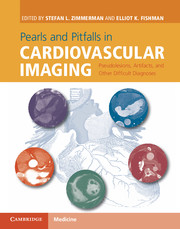 Pearls and Pitfalls in Cardiovascular Imaging
Pearls and Pitfalls in Cardiovascular Imaging Book contents
- Frontmatter
- Contents
- List of contributors
- Preface
- Section 1 Cardiac pseudotumors and other challenging diagnoses
- Section 2 Cardiac aneurysms and diverticula
- Section 3 Anatomic variants and congenital lesions
- Section 4 Coronary arteries
- Section 5 Pulmonary arteries
- Section 6 Cardiovascular MRI artifacts
- Section 7 Acute aorta and aortic aneurysms
- Case 54 Pitfalls in arterial enhancement timing
- Case 55 Misdiagnosis of acute aortic syndrome in the ascending aorta due to cardiac motion
- Case 56 Aortic pseudodissection from penetrating atherosclerotic ulcer
- Case 57 Ductus diverticulum mimicking ductus arteriosus aneurysm
- Case 58 Pericardial recess mimicking traumatic aortic injury
- Case 59 Neointimal calcifications mimicking displaced intimal calcifications on unenhanced CT
- Case 60 The value of non-contrast CT in vascular imaging
- Case 61 Shearing of branch arteries in intramural hematoma: a mimic of active extravasation
- Case 62 Imaging features of aortic aneurysm instability
- Case 63 Aortoenteric fistula
- Case 64 Infammatory aortic aneurysm
- Case 65 Incorrect aneurysm measurement due to aortic tortuosity
- Section 8 Post-operative aorta
- Section 9 Mesenteric vascular
- Section 10 Peripheral vascular
- Section 11 Veins
- Index
- References
Case 56 - Aortic pseudodissection from penetrating atherosclerotic ulcer
from Section 7 - Acute aorta and aortic aneurysms
Published online by Cambridge University Press: 05 June 2015
- Frontmatter
- Contents
- List of contributors
- Preface
- Section 1 Cardiac pseudotumors and other challenging diagnoses
- Section 2 Cardiac aneurysms and diverticula
- Section 3 Anatomic variants and congenital lesions
- Section 4 Coronary arteries
- Section 5 Pulmonary arteries
- Section 6 Cardiovascular MRI artifacts
- Section 7 Acute aorta and aortic aneurysms
- Case 54 Pitfalls in arterial enhancement timing
- Case 55 Misdiagnosis of acute aortic syndrome in the ascending aorta due to cardiac motion
- Case 56 Aortic pseudodissection from penetrating atherosclerotic ulcer
- Case 57 Ductus diverticulum mimicking ductus arteriosus aneurysm
- Case 58 Pericardial recess mimicking traumatic aortic injury
- Case 59 Neointimal calcifications mimicking displaced intimal calcifications on unenhanced CT
- Case 60 The value of non-contrast CT in vascular imaging
- Case 61 Shearing of branch arteries in intramural hematoma: a mimic of active extravasation
- Case 62 Imaging features of aortic aneurysm instability
- Case 63 Aortoenteric fistula
- Case 64 Infammatory aortic aneurysm
- Case 65 Incorrect aneurysm measurement due to aortic tortuosity
- Section 8 Post-operative aorta
- Section 9 Mesenteric vascular
- Section 10 Peripheral vascular
- Section 11 Veins
- Index
- References
Summary
Imaging description
Axial images of the aorta that are perpendicular to a penetrating atherosclerotic ulcer may demonstrate a displaced intimal flap (Figure 56.1), suggestive of a dissection. However, upon inspection of the coronal oblique multiplanar reformats, penetrating atherosclerotic ulcers (PAUs) are easily distinguished from dissection (Figure 56.2). Penetrating atherosclerotic ulcers will communicate with the aortic lumen via a single, narrow-necked intimal defect. Dissections communicate with the aorta through at least two separate intimal defects at the proximal entry point and the distal exit point with an intervening false lumen. The appearance of a pseudodissection from large PAUs occurs when the PAU is viewed in a plane perpendicular to its long axis. At the levels near the proximal and distal neck of the ulcer where the PAU projects along the long axis of the aorta, the wall of the ulcer compressed against the wall of the aorta can simulate a displaced intimal flap.
Importance
Distinguishing between a large PAU and an aortic dissection is important for the immediate management of the patient. A type B dissection is typically managed without surgical intervention. However, an enlarging PAU, such as in this patient, may lead more expediently to surgical repair, particularly if the patient is acutely symptomatic.
Typical clinical scenario
Penetrating atherosclerotic ulcers and aortic dissection lie on the spectrum of acute aortic syndrome. When symptomatic, PAUs can have a similar clinical presentation to acute aortic dissection, consisting of a sudden onset of chest pain and discomfort. There is debate as to whether penetrating atherosclerotic ulcers can progress to aortic dissection. PAUs are often discovered incidentally during CT angiography.
Differential diagnosis
Differential considerations for an apparent displaced intimal flap commonly include aortic dissection or traumatic aortic injury, as well as artifacts from beam hardening or cardiac motion. However, this case illustrates that in patients with severe atherosclerosis and hypertension, a large PAU resulting in a pseudodissection should also be considered. Multiplanar reformats are valuable in cases such as these to distinguish between true dissections and large PAUs imitating dissection.
Information
- Type
- Chapter
- Information
- Pearls and Pitfalls in Cardiovascular ImagingPseudolesions, Artifacts, and Other Difficult Diagnoses, pp. 179 - 180Publisher: Cambridge University PressPrint publication year: 2015